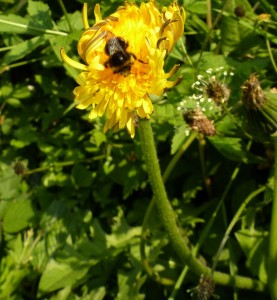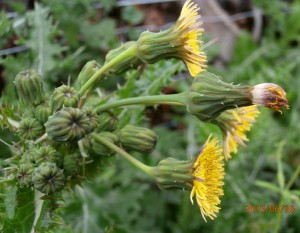We’ve all been there, gently identifying plants in the lawn and behold, a yellow Dandelion-like plant!
The thought processes go something like this:
Behold a yellow Dandelion-like plant. But IS it a Dandelion? Perhaps it’s a Sow Thistle? Or maybe a Hawkbit? Or do I mean a Hawk’s-beard? Oh no! is it a Cat’s-ear? Arrrgh! Perish the thought, could it be a Hawkweed?!
There are a lot of candidates to be sure and Dr M has never found the common names very memorable or helpful in distinguishing this diverse but superficially rather similar group!
But listen to the plant and examine the leaves, stems and flowers carefully and you will soon be able to get to a genus with confidence!
Let’s rewind from above:
“But is it Dandelion?”
 Check the flower stem, if it is unbranched and hollow with white latex and with a single capitulum (head) and the leaves confined to a basal rosette, it’s a Dandelion, Taraxacum species. Actually a very complex and difficult group with hundreds of apomictic microspecies. The common and garden Dandelions will usually fit: Taraxacum officinale agg. or Taraxacum section Ruderalia!
Check the flower stem, if it is unbranched and hollow with white latex and with a single capitulum (head) and the leaves confined to a basal rosette, it’s a Dandelion, Taraxacum species. Actually a very complex and difficult group with hundreds of apomictic microspecies. The common and garden Dandelions will usually fit: Taraxacum officinale agg. or Taraxacum section Ruderalia!
“Oh no! is it a Sow Thistle?”
 This is the most thistle-like of the yellow composites so pretty easy to tell from the others. In Sow Thistles the flower stems are hollow but branched (so not a Dandelion) with white latex turning orange with time and with glaucous or bright green leafy stems and leaves with auricles. Common Sow Thistles, Like Sonchus asper (Prickly Sow Thistle illustrated) tend to be weeds so you wont find this in grassland unless it is growing in trampled or otherwise disturbed areas.
This is the most thistle-like of the yellow composites so pretty easy to tell from the others. In Sow Thistles the flower stems are hollow but branched (so not a Dandelion) with white latex turning orange with time and with glaucous or bright green leafy stems and leaves with auricles. Common Sow Thistles, Like Sonchus asper (Prickly Sow Thistle illustrated) tend to be weeds so you wont find this in grassland unless it is growing in trampled or otherwise disturbed areas.
All the rest have solid flower stems.
“Or maybe a Hawkbit?”
- Leontodon saxatalis
- Lesser Hawkbit capitulum
- Forked hairs
- Red spot-based hairs on midrib
If the flower stem is unbranched and leafless with leaves in a basal rosette only and very hairy and with forked hairs then it’s a Hawkbit (Leontodon spp.) and what’s more if the forked hairs on the midrib above have red bases than it is Lesser Hawkbit (Leontodon saxatalis).
- Scorzoneroides autumnalis
- Autumn Hawkbit – capitulum
- Leaf with narrow lobes and simple hairs
If the flower stem is branched 2 or 3 times but leafless and the basal rosette leaves with unforked hairs and the capitulum tapering into the flower stalk (rather than abruptly contracted as in the others) then it is Autumn Hawkbit (Scorzoneroides autumnalis – syn: Leontodon autumnalis)
“Or do I mean a Hawk’s-beard?”
- Crepis capillaris
- Smooth Hawk’s-beard – capitulum
- White pappus with simple hairs
- Leaf with few unforked hairs
The Hawk’s-beards (Crepis spp.) have branched flower stem with hairy or hairless leaves, the important thing though is the capitulum has just two rows of phyllaries (the bracts on the capitulum), one short row and one longer and the pappus hairs are white and simple (not feathery). Crepis capillaris (Smooth Hawk’s-beard) is the common one in lawns, grasslands and waste places).
“Perhaps it’s a Cat’s-ear?”
- Hypochoeris radicata
- Cat’s-ear – capitulum
- Achenes with pappus (r) and receptacular scales (l)
- Leaf with unforked hairs
If the flower stem is branched, leafless and the basal rosette leaves are very hairy but without forked hairs, it could be a cat’s ear. Check the capitulum and if there are extra scales in the capitulum (receptacular scales) amongst the achenes which have a brownish pappus with both simple and feathery hairs, then it is a Cat’s-ear. Hypochaeris radicata (sometimes spelled Hypochoeris – Common Cat’s-ear) is the common one in lawns and neutral grasslands and meadows.
“Arrrgh! Perish the thought, could it be a Hawkweed?!”
 This is another complex group with hundreds of apomictic micro-species. Hawkweeds (Hieracium spp.) are usually hairy often with multicellular hairs and branched and leafy flower stems and the capitulum with many overlapping rows of phyllaries.
This is another complex group with hundreds of apomictic micro-species. Hawkweeds (Hieracium spp.) are usually hairy often with multicellular hairs and branched and leafy flower stems and the capitulum with many overlapping rows of phyllaries.
Dr M says: I hope this post is useful in helping you distinguish between the various possible alternative yellow composites. Contact Dr M with your thoughts and tips for this helping with these yellow devils!
















